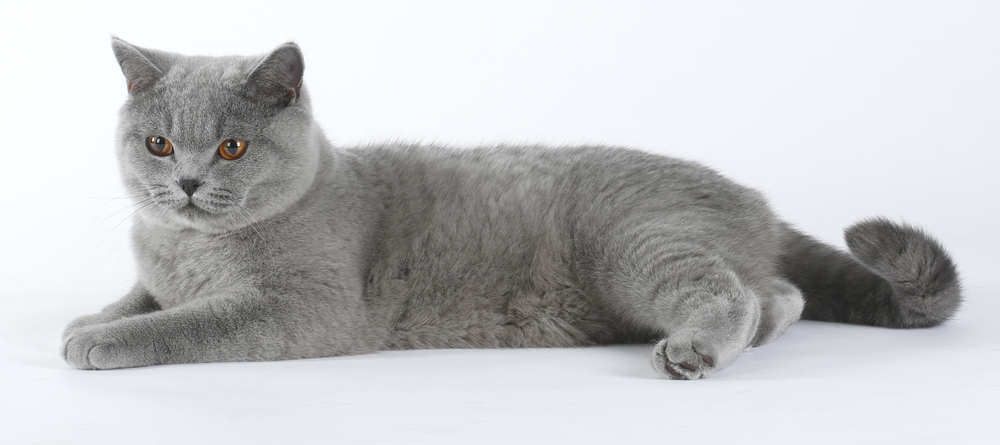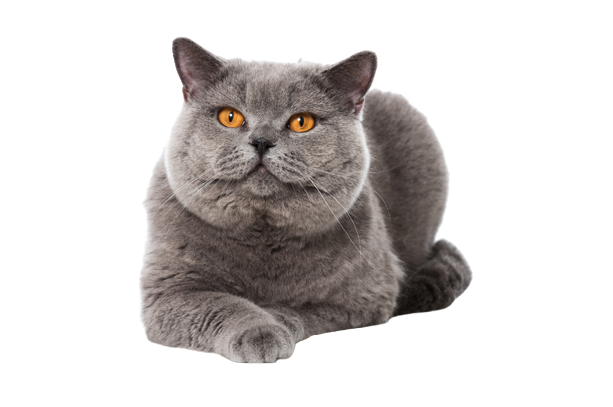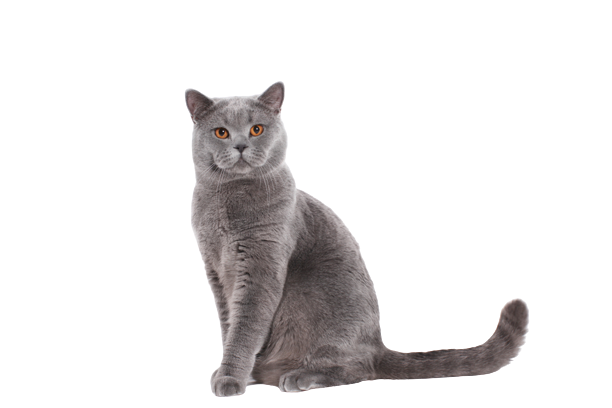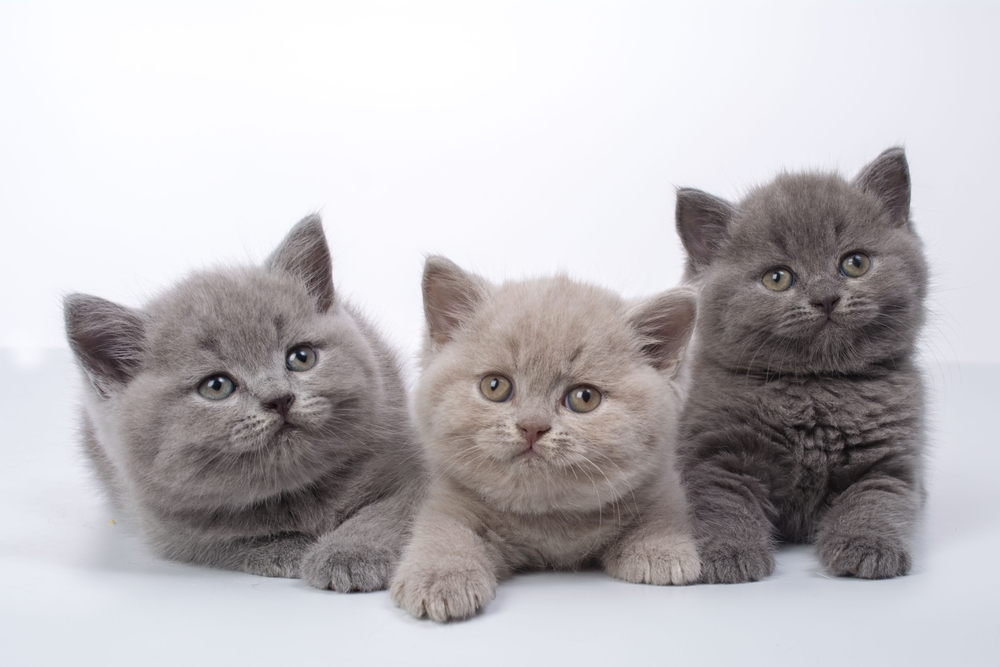Briefly The British Shorthair is;

Known for their chubby face and easy-going demeanour, the British Shorthair is one of the oldest breeds. They are best known for their “blue” (grey) coats but come in a variety of colors. Find out more about this breed and if the British Shorthair is right for you and your family.
- Temperament: Calm, Cuddly, Independent
- Size: Medium to large
- Kittens: 3-6 pounds when ready to leave for new homes at 3 months.
- Adult females: Medium to large, 8-11 pounds
- Adult males: Large, 10-16 pounds
- Colors: British Shorthairs are best known for having blue, commonly
known as grey, fur but they come in a variety of colors - Life Expectancy: 12-20 years, depending on background and life
circumstances.
About the British Shorthair
British Shorthair’s warm and lovable personality combined with their independent nature makes them a top choice for many families.

In line with their British heritage, the breed is slightly reserved, but once they get to know someone, they have no trouble showing affection.
Male and female British Shorthair cats differ a bit in personality. The happy-go-lucky males command respect but welcome attention from everyone, while the more serious females are true British ladies expecting proper form and etiquette from
those whose they accept. These loyal and devoted companions’ cats but want to be where you are, snuggling up beside you on the sofa. Often resembling a sturdy teddy bear, the British Shorthair’s smile and a plush coat combined with their wonderful disposition makes them great family pets*.
*credit; TICA.org
Personality

The British Shorthair is a very pleasant cat to have as a companion. She is easy going and placid. The British is a fiercely loyal, loving cat and will attach herself to every one of her family members.
While the British loves to play, she doesn’t need hourly attention. If she is in the mood to play, she will find someone and bring a toy to that person. The British also plays well by herself, and thus is a good companion for single people.
Living With

The British Shorthair is a thick, muscular cat so her nutrition must be carefully controlled. Despite her heavy boning and musculature, you want to make certain she keeps a proper weight and does not get out of condition. She must get adequate exercise. Interactive play may be necessary to keep the breed in good shape. The British will play when she wants to play and will find a toy or create one out of anything she finds if a cat toy is not available.
A daily brushing is important, especially during seasonal changes when the coat is thickening or thinning. Even this Shorthair cat can get knots in her coat if she isn’t brushed regularly.
The British tolerates being left alone. She is affectionate but also spends time just sleeping in the sun. The British is an easy cat to care for and makes a wonderful, quiet companion.

History
Humble street cat of Britain?... Not anymore
The British Shorthair, while originally coming from the farms and streets of Britain, is also considered to be the first cat of the cat fancy. The ‘father’ of this breed is Harrison Wier, who is thought of as the first professional cat breeder. He is known in cat fancy history as the ‘Father of the Cat Fancy’; Not only was he the first professional breeder, but he also determined the rules for the first cat show, which was held in Britain in 1871.
As if this were not enough, Harrison took the humble street cat of Britain and, through an intensive breeding program, transformed it to the pedigreed breed that he named the British. The British fell in love with their new now-pedigreed breed. When the Persian was introduced into Britain, it nudged out the British for the most popular breed temporarily. During the Second World War, as in the First World War, the British Shorthair breed was decimated, but it always re-emerged into the top ranks of popularity. Today, the British shorthair is accepted in cat registries worldwide. At one time, it was known as the British Blue, but since it comes in a variety of colors, it is called either the British or the British Shorthair

Activity Level
Originating as a hunter and protector of food supplies for Roman soldiers when they invaded Great Britain, the British Shorthair now prefers cuddling with their families and occasionally playing with toy mice.
Originating as a hunter and protector of food supplies for Roman soldiers when they invaded Great Britain, the British Shorthair now prefers cuddling with their families and occasionally playing with toy mice.
British Shorthairs are known to be loyal and devoted companions. They are not lap cats, however and prefer quietly snuggling beside you on the sofa. While not very active cats, they do have their occasional “mad” moments where they like to act like kittens. These intelligent cats are quiet and unobtrusive, ruling their indoor kingdoms with a calm demeanour. They look before they leap and do not engage in high-flying acrobatics. They are tolerant with children and dogs, but do not like to be carried around. Exerting their independence, they are content with their own company and have no problem quietly amusing themselves in your absence and waiting patiently for your return.
Care
Grooming
The British Shorthair coat is short but very dense. Combing with a wide-toothed metal comb once a week will help reduce shedding during a change of seasons. Aside from ageing cats, most British Shorthairs are capable of bathing themselves unless their coat becomes soiled with something that would be harmful to lick off. Keep their nails trimmed every two weeks and their ears cleaned and teeth brushed regularly with a vet-approved pet toothpaste. A tall scratching pole is also recommended to help their natural scratching instinct.
Nutrition
Adult British Shorthairs are calm and therefore need less food than most would expect given their size. Feed adults twice daily on a regular schedule (preferably wet food high in meat content) while kittens should be fed more frequently. Free feeding is not recommended to discourage cats from eating when they are bored. Use only treats and food without sugar.
As with all cats, it is important to give them fresh, clean water daily, so they don’t hesitate to drink. The water bowl should be placed at least three feet away from any food. Cats’ noses are sensitive, and an overwhelming smell of food may cause them to drink less.
Health
The British Shorthair breed is known to be very robust however, as with all cats, they are at risk for the most common heart disease, HCM (hypertrophic).
This is a genetic disease that can result in heart failure and death, so it is of paramount importance that breeders diligently screen for this via echocardiogram performed by a Veterinary Cardiologist. Because HCM doesn’t always show up in the first years of life, it is
important for pet owners to proactively screen for this disease as well. It is also important to schedule annual with a veterinarian as untreated dental problems can lead to other health issues if gone untreated.
